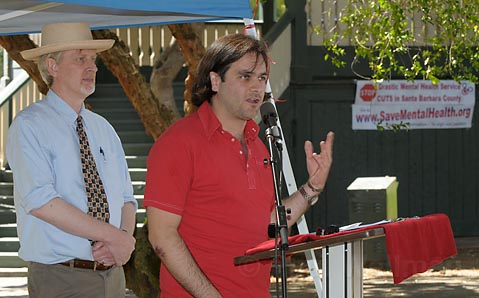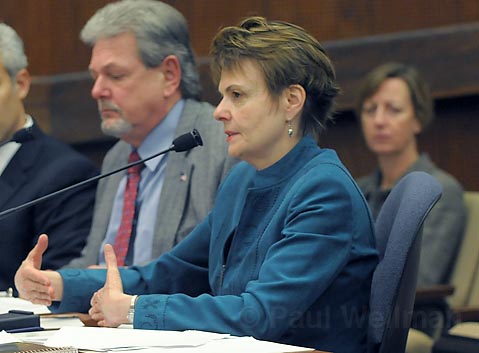Dark Cloud Over Mental Health
Supes Urge Staff to Brainstorm Alternative Budget Cuts

Ann Detrick, who began in January as director of Santa Barbara County’s Alcohol, Drug and Mental Health Services, may very well have the most difficult job in the county. Leaders of community-based agencies seem willing to admit it, some community members think so, and even members of the Board of Supervisors say so. But not Detrick. “Unequivocally, no,” she said after an April 22 meeting in which she presented a 2008-09 fiscal year plan detailing devastating cuts to mental health programs for the sake of balancing the department’s budget. She’d probably be willing to admit she’s in a tight spot, however, as her plan-mandated by the board in February as part of a deal to escape $6.9 million in deficit for this fiscal year-includes cutting $8.4 million from her annual $34.8 million budget.
The board “saw the face of mental health” as one speaker put it, sitting through more than five hours of sometimes tearful, sometimes angry testimony from dozens upon dozens of people who would be affected by cuts to the county’s mental health services. Repeatedly, people took the podium and shared with the board their stories of homelessness and addiction and suicide attempts-all as a result of mental illness. But each story contained an element of hope as well, because most all of the people also spoke of care they received from the county’s bevy of community-based organizations whose purpose it is to get them into housing and on the medication they need to be productive members of society again. “I felt a lot of sadness, but also a lot of hope,” 2nd District Supervisor Janet Wolf said. “The people who spoke really touched us.”

The April 22 meeting was a preview of what is sure to be a contentious round of budget hearings in June. With a projected $30 million likely being cut from the county’s budget, supervisors will be seeing department after department coming forward with reasons why they should be spared. And depending on the coming weeks, other departments could see more hits coming than originally anticipated.
Comments from some members of the board-while appreciative of the work gone into developing the plan-showed they were unhappy with its content. “The budget proposed is one I’m not happy with,” Wolf said, adding the plan would “dismantle” programs built over many years that were quite effective in the services they provided. A more creative approach was in order, the supervisors indicated with a unanimous vote mandating county staff to rethink the situation and return with a “myriad of options,” whether that means using county reserves, enacting fees, or taking money from other departments. “It was a good effort,” said 1st District Supervisor Salud Carbajal. “I think everybody tried to come together but it fell short.”
In the $8.4 million cuts would be the permanent loss of 44 positions currently unfilled within the department, plus the reduction of 30 more, according to county staff. They estimate the number of clients lost as a result of reduced staff would be around 500 people-but specifically 500 people who do not have a serious mental health diagnosis. But nonprofit agency directors claim the number to be between 800 and 1,000, based on documents given to them in meetings by county staff. “In Santa Barbara County we do not make people homeless on purpose,” said Mike Foley, executive director of homeless shelter Casa Esperanza. Some housing agency leaders claim that entire programs would be eliminated, resulting in people regressing back to their former, less stable selves. Foley and others were cautiously optimistic at the end of the meeting, intending to wait and see what the coming months held for their programs before rendering a decision on the rhetoric used at the meeting. There is already some hope, however, for nonprofits: According to ADMHS Deputy Director Marianne Garrity, the county is currently waiting for proposals from supportive housing providers on how a set-aside $825,000 could be used.
But the $8.4 million spoken of at the meeting could just be the tip of the iceberg. In the midst of an attachment to the April 15 Board of Supervisor’s agenda, County CEO Mike Brown listed a possible $10 million “true-up” that ADMHS owes the state because its “actual revenue may be less than the amount claimed from state.” The true-up was listed with 24 other revenue and expenditure problems that could soon be plaguing the county. Throughout each year, the county gets reimbursed by the state for various Medi-Cal expenses it incurs. But every couple of years, the state will audit the reimbursements to see if the specific uses intended for Medi-Cal are being realized. As a result, the county sometimes owes the state money. But never to the tune of $10 million, Brown admitted Tuesday, adding that the discrepancy, the total of which is still being calculated, probably came as a result of “mis-billing” by county staff who may have used the wrong codes on billing statements.
Nancy Kincaid, spokesperson for the state Department of Mental Health, said via email that she was unable to determine what the county meant by the line item, and was unable to shed any light on what was represented in the report. Brown said he will be recommending that any leftover money the county may find at the end of the fiscal year be set aside to help offset this potentially huge Medi-Cal cost to the county.



